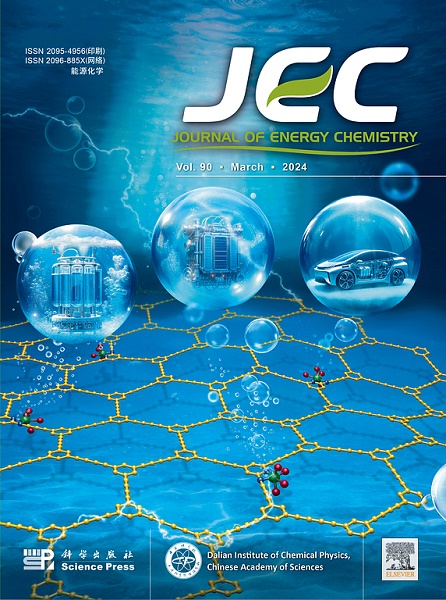Ceria-driven synergistic nourishment of polarized silver overcoming the trade-off between faradaic efficiency and current density for CO2 electroreduction to CO
IF 13.1
1区 化学
Q1 Energy
引用次数: 0
Abstract
Although the potential of microenvironment modulation to enhance electricity-driven CO2 reduction has been recognized, substantial challenges remain, particularly in effectively integrating multiple favorable microenvironments. Herein, we synthesize CeO2 with abundant oxygen vacancies to effectively disperse and anchor small-sized Ag2O nanoparticles (Ag2O/Vo-CeO2). Vo-CeO2 acts as a multifunctional modulator, regulating both the reaction microenvironment and the electronic structure of Ag sites, thereby boosting CO2 reduction (CO2RR) efficiency. Its strong CO2 adsorption and H2O dissociation capabilities facilitate the supply of CO2 and active *H species to Ag sites. The electron-withdrawing effect of Vo-CeO2 induces polarization at interfacial Ag sites, generating Agδ+ species that enhance CO2 affinity and activation. Moreover, the electronic coupling between Vo-CeO2 and Ag upshifts the d-band center of Ag, optimizing COOH binding and lowering the thermodynamic barrier of the potential-determining step. Ag2O/Vo-CeO2 delivers a consistently high Faraday efficiency (FE) of over 99% for CO production even at industrially current density (up to 365 mA cm−2 herein), and the operational potential window spans an astonishing 1700 mV (FE >95%). The unprecedented activity, which overcomes the trade-off between the selectivity and current density for CO2RR, outperforms state-of-the-art Ag-based catalysts reported to date. These findings offer a promising pathway to develop robust CO2RR catalysts and present an engineering strategy for constructing the optimal microenvironment of active sites via the synergistic effects of multifunctional modulation.

氧化铈驱动的极化银的协同滋养克服了CO2电还原CO时法拉第效率和电流密度之间的权衡
尽管人们已经认识到微环境调节在提高电力驱动的二氧化碳减排方面的潜力,但仍存在重大挑战,特别是在有效整合多个有利的微环境方面。本文中,我们合成了具有丰富氧空位的CeO2,以有效地分散和锚定小尺寸Ag2O纳米颗粒(Ag2O/Vo-CeO2)。Vo-CeO2作为一种多功能调节剂,调节反应微环境和Ag位点的电子结构,从而提高CO2还原(CO2RR)效率。其较强的CO2吸附和H2O解离能力有助于向Ag位点提供CO2和活性*H物质。Vo-CeO2的吸电子效应在界面Ag位点诱导极化,生成Agδ+物质,增强CO2亲和力和活化能力。此外,Vo-CeO2和Ag之间的电子耦合使Ag的d带中心上移,优化了COOH结合,降低了势决定步骤的热力学势垒。Ag2O/Vo-CeO2即使在工业电流密度(这里高达365 mA cm - 2)下也能提供超过99%的持续高法拉第效率(FE),并且工作电位窗口跨越惊人的1700 mV (FE >95%)。这种前所未有的活性克服了CO2RR的选择性和电流密度之间的权衡,优于迄今为止报道的最先进的银基催化剂。这些发现为开发强大的CO2RR催化剂提供了一条有希望的途径,并提出了通过多功能调制的协同效应构建活性位点最佳微环境的工程策略。
本文章由计算机程序翻译,如有差异,请以英文原文为准。
求助全文
约1分钟内获得全文
求助全文
来源期刊

Journal of Energy Chemistry
CHEMISTRY, APPLIED-CHEMISTRY, PHYSICAL
CiteScore
19.10
自引率
8.40%
发文量
3631
审稿时长
15 days
期刊介绍:
The Journal of Energy Chemistry, the official publication of Science Press and the Dalian Institute of Chemical Physics, Chinese Academy of Sciences, serves as a platform for reporting creative research and innovative applications in energy chemistry. It mainly reports on creative researches and innovative applications of chemical conversions of fossil energy, carbon dioxide, electrochemical energy and hydrogen energy, as well as the conversions of biomass and solar energy related with chemical issues to promote academic exchanges in the field of energy chemistry and to accelerate the exploration, research and development of energy science and technologies.
This journal focuses on original research papers covering various topics within energy chemistry worldwide, including:
Optimized utilization of fossil energy
Hydrogen energy
Conversion and storage of electrochemical energy
Capture, storage, and chemical conversion of carbon dioxide
Materials and nanotechnologies for energy conversion and storage
Chemistry in biomass conversion
Chemistry in the utilization of solar energy
 求助内容:
求助内容: 应助结果提醒方式:
应助结果提醒方式:


